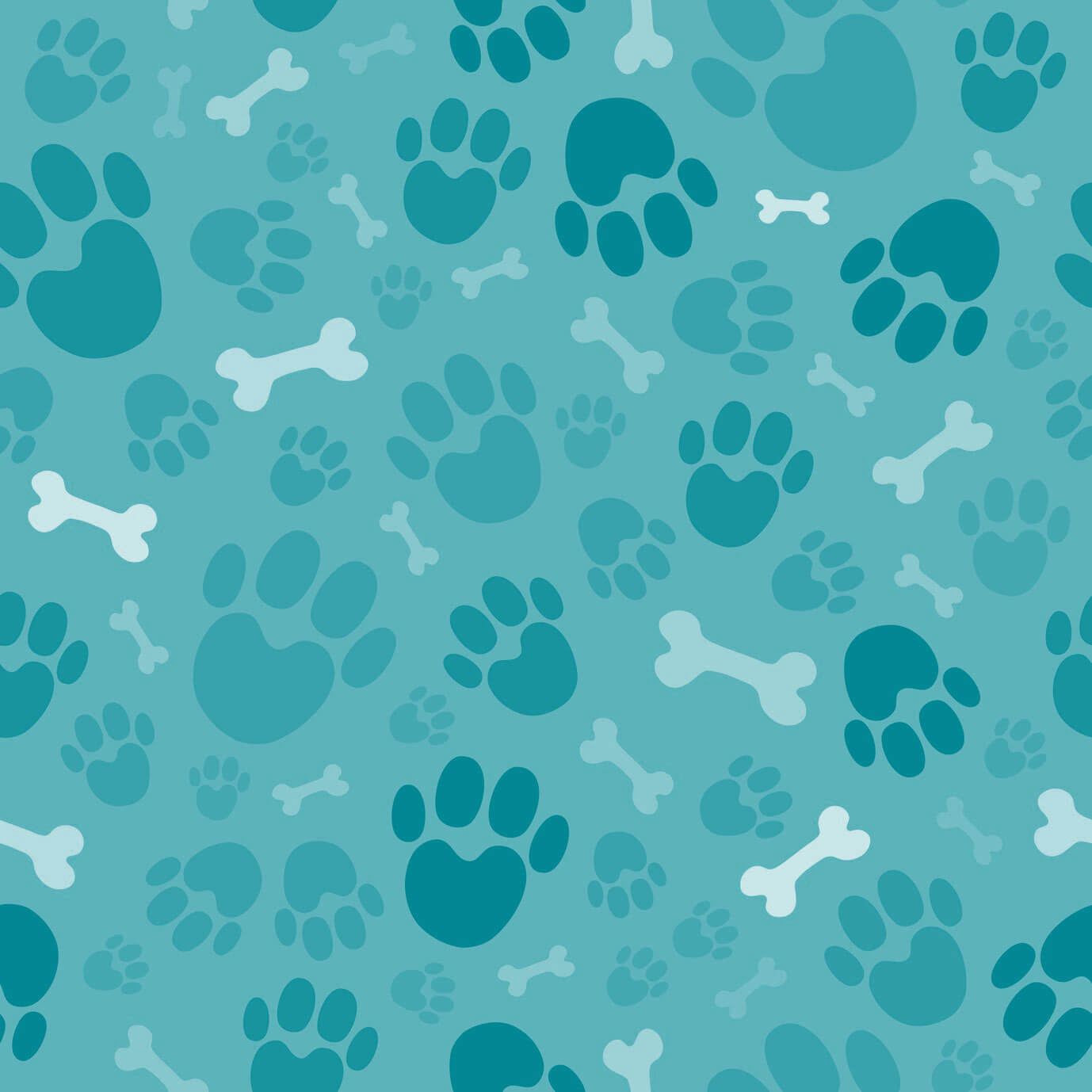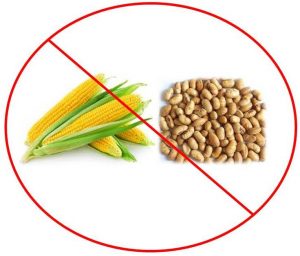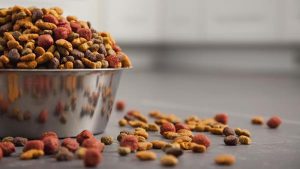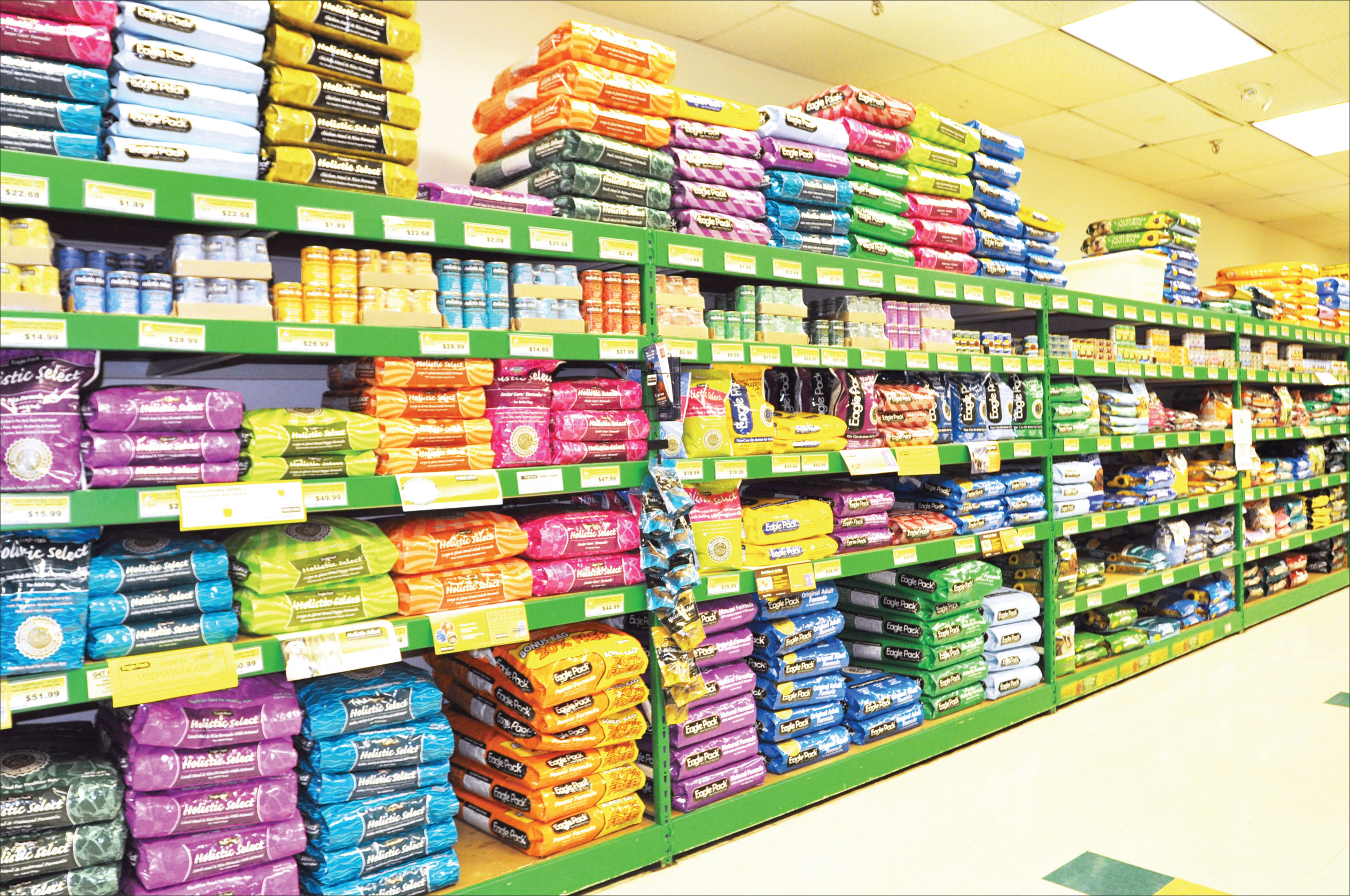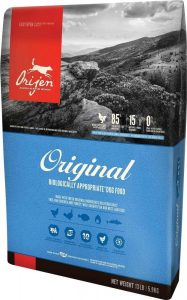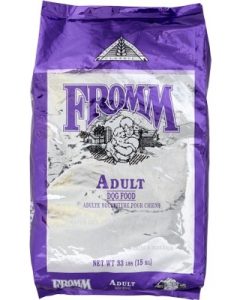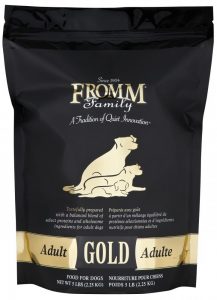15 Things To Look For And Avoid In A Dog Food
As dog lovers, we naturally have our pup’s best health interests at heart and assume anyone else in the animal industry does as well.
However, one of the most important industries when it comes to the health of your dog – the dog food industry – often falls extremely short in having an interest in Fido’s health. In fact, most dog food brands contain toxic ingredients and additives that can be poisonous to your dog.
We’ve compiled a comprehensive list below so you can discover what they are, how to avoid them, and what your best options are when it comes to quality dog food.
Toxic Ingredients
While you would assume dog food companies would avoid adding toxic ingredients to your pooch’s daily meal, it’s unfortunate that the opposite is true. Companies commonly add unhealthy ingredients (and even downright toxic ones) to even the most innocent-looking kibble.
Avoid:
• Garlic and onion
Garlic and onions are added to some dog food brands as flavor enhancers. However, these bulbs are members of the shallot family, which along with leeks, scallions, chives, and shallots, can cause anemia in dogs if consumed in small amounts over time.
• Food dyes
Chemical food dyes like Red Dye 40, or other color names with numbers behind them, are common additions to dog food. However, these food dyes aren’t added for the benefit of your pup – they’re intended to entice the consumer. For instance, if a brand claims a formula includes fresh veggies, you’d naturally associate this with shades of green, not necessarily burnt orange and brown kibble. So, with the help of a little green food dye, the “problem” is solved, right? Not so much – these food dyes have been shown to cause behavior problems very similar to ADHD in humans, such as hyperactivity and inattentiveness.
• Wheat gluten
Wheat gluten is a protein found in wheat, which is commonly added to dog food to improve texture or cut costs by decreasing how much meat needs to be added to the food. Unfortunately, dogs are carnivores and are not designed to eat grains. Furthermore, research has shown that most grains in the US, including wheat, are genetically modified and can cause intestinal inflammation and autoimmune disorders.
• Meat by-products
Meat by-products consist of organs and other tissues obtained from dead animals that aren’t used for human consumption. And while some companies ethically source organs and other “leftover” parts of animal carcasses, most obtain by-products from roadkill and even euthanized pets from animal shelters, which can contain harmful bacteria as well as euthanasia chemicals that may be passed on to your pooch.
• Corn and soy
Corn and soy are other popular grain additives used to cut costs. Like wheat gluten, most are genetically modified and can cause digestive issues and damage to the gut lining (not to mention, dogs are carnivores whose digestive tracts aren’t designed for heavy grain consumption).
• Carrageenan
Carrageenan is a thickener and stabilizer commonly used in many foods (including human foods) that has been shown to cause intestinal ulcerations, gastrointestinal inflammation, and even cancer in both human and animal studies.
• Sorbitol
Sorbitol is a sugar alcohol molecule commonly used as an artificial sweetener in human and animal foods. Even though it is sugar-free, it has been shown to raise blood sugar in dogs, which could lead to hyperactivity.
• Xylitol
Xylitol is another sugar alcohol added as an artificial sweetener to human and dog foods. It has been shown to cause hypoglycemia in dogs, as well as acute, life-threatening liver disease.
• Propylene glycol
Propylene glycol (an ingredient also found in antifreeze) is a chemical found in processed foods as well as cosmetic products. Propylene glycol is commonly used to help maintain moisture in mixtures but has been shown in studies to cause skin irritation and kidney damage.
• Ethoxyquin (“Fish meal”)
Ethoxyquin (also listed as “fish meal,” though it is a far cry from “fish”) is a chemical preservative used to prevent fats in dog food from going rancid. Its side effects are so detrimental that it has officially been banned in the European Union; however, it’s still used in the U.S. Research shows it can cause hemorrhage, liver damage, cancer, kidney damage, and thyroid damage.
• Butylated Hydroxyanisole (BHA)
BHA is another ingredient added to dog food to prevent fats from going rancid. It is a synthetic antioxidant that has shown in studies to cause cancer and fuel its growth in rat stomachs and has been listed as a carcinogen (even to humans) on California’s Prop 65 list.
• Butylated Hydroxytoluene (BHT)
Like BHA, BHT is added to processed foods to prevent fats from going rancid. Similarly, it has been shown to cause cancer, and increase the incidence of pulmonary and pituitary tumors in mice, even at a low dosage.
• Rendered fat
Rendered fat is fat that is obtained from animals. It is extremely hard to trace where it has been sourced from, but many companies obtain it from leftover meat by-products (slaughtered or roadkill animals) that can be contaminated with plastics, antibiotics, and even traces of sodium pentobarbital, the drug used to euthanize animals.
Look for:
• Natural moisturizers
Oils like coconut or olive oil keep dog food moist.
• Meat and vegetables as main ingredients
Meat and veggies should be the main ingredients with a dash of herbs thrown in. Avoid grains or look for a “grain-free” line. A dash of brown rice and oatmeal that are gluten-free are okay.
• No coloring added
Look for brands that have no coloring added and/or who use natural color options like beet juice or annatto.
• Herbs like rosemary, oregano, parsley, or basil
Rosemary, oregano, parsley, and basil are completely natural and non-toxic to your pup, while also adding a flavor boost.
• Gluten-free
Look for lines that don’t contain any gluten, wheat, barley, or other “flours,” especially if your pup is sensitive to grains.
• Named meats
Look for meat sources that are named, such as “chicken breast” or “turkey breast” instead of vague descriptions like “meat.”
• Brands without carrageenan
Avoid brands with carrageenan or suspicious names you’ve never seen before (more on vague terms and descriptions below).
• Brands without artificial sweeteners
Steer clear from recipes that have sorbitol, xylitol, or other artificial sweeteners.
• Quality oils and natural preservatives
It’s best to look for brands that contain oils that don’t easily oxidize (like coconut) so that they don’t have to add chemical preservatives. Also look for natural preservatives, like vitamin C and vitamin E, also called “tocopherols.”
• Healthy fats
Look for healthy fats from coconut, olive, or even avocado oils.
Mystery Ingredients (With Vague Descriptions)
You’ll probably notice that many ingredients in popular dog brands are vague. The vaugeness is intentional, as it gives the ingredients a “cleaner” look and feel. Below are the most common vague words that could be hiding one of the above toxic ingredients.
Avoid:
• “Meat”
Meat by-products can be listed under vague names such as “meat.” Since all meat from a carcass is considered “meat,” there is no lawful issue with companies using the term under the FDA.
• “Meal” or “Meat Meal” or “Bone Meal”
The American Association of Feed Control Officials, in conjunction with the FDA, allows anything that’s labeled “meat meal” to be sourced “from mammals other than cattle, pigs, sheep, or goats without further description,” which means you have no idea what it contains. Unfortunately, “meal” and “meat meal” are commonly sourced from deceased livestock and expired grocery meat.
• Corn meal
Corn meal may make you visualize ground corn, but keep in mind that it is also a grain, and most in the U.S. is genetically modified, as we mentioned above in the toxic ingredients list.
Look for:
• Specific meat names
Look for specific named meats in the dog food, such as “Beef,” “Turkey,” “Chicken Breast,” or “Salmon.”
• Transparent meat labels
Look for whole and transparent meat labels, such as “chicken breast” or “beef,” or even “chicken meal,” so you at least have an inkling of what it contains.
• Whole ingredients
Look for whole ingredients on the label consisting of named meats, veggies, fruits, and herbs.
Potentially Harmful Additives
Harmful additives are similar to the toxic ingredients listed above. However, some can have more obscure names or labels.
Avoid:
• “Natural flavor”
While you may assume “natural” flavor is just that: a natural flavor from ingredients like veggies, spices, or meat, it’s more often than not an obscure additive. According to the FDA, “natural flavor” refers to “…’digests,’ which are materials treated with heat, enzymes, and/or acids to form concentrated natural flavors.”
They go on to explain, “Only a small amount of a ‘chicken digest’ is needed to produce a ‘Chicken Flavored Cat Food,’ even though no actual chicken is added to the food.”
In other words, you don’t know what “natural flavor” consists of, or if it’s even natural at all.
Look for:
• Herbs or named flavors
It’s best to steer clear of any “natural flavoring” and look for herbs or “labeled” flavors, such as “natural flavoring” from a spice blend.
Wet Foods with Gravy
The problem with wet dog foods “with gravy” or listed as “stews” isn’t necessarily that extra water is bad for your pooch. Wet food has more to do with product weight and nutrient density, as the FDA states that the moisture content for dog food must not exceed 78 percent. However, a loophole exists where brands can label their food a “stew,” “in sauce,” or “in gravy,” and exceed this amount, adding up to 87.5 percent.
What this means is that you may essentially be paying for more water in your dog food and fewer nutrients, as the water adds to the weight and bulks up the food without maximizing protein and nutrient content. Aka: you could be paying more for less.
Avoid:
• Obscure wet food labels
Steer clear of labels with “gravy,” “stew,” or “sauce.”
Look for:
• Protein as the first ingredient
Search for dry food or “pate” which has a high ratio of protein, usually as the first ingredient.
Protein Content
Ideally, you want to make sure that the brand of dog food you choose has a whole protein source listed as the first ingredient, followed by high-quality ingredients like veggies. Companies often practice “ingredient splitting” which splits up inferior ingredients (like ground corn and wheat flour). Ingredient splitting makes it appear as if there is less of those inferior ingredients than the protein that is first listed.
Avoid:
• Plant proteins such as “pea,” “soy,” “corn,” or “potato” protein.
Plant proteins are often used as cheaper alternatives to higher quality meat proteins, and considering many are grain-based and genetically modified, they could harm your pup in the long term.
Look for:
• Whole meats
Make sure whole protein sources such as “chicken breast,” “lamb,” “salmon,” or “beef” are listed in the first three ingredients followed by veggies.
Other Important Considerations
Accessibility
Of course, being able to buy a great dog food is important. If you find the dog food brands in your local grocery just aren’t making the cut, be sure to check out Amazon or even the manufacturer’s website of great dog food brands (like the ones listed below) – they may be able to ship to you directly.
Product Consistency
Some brands offer varying “tiers” of quality in their dog food lines. For instance, their top-level option may be strictly high-quality meats and vegetables, while their lower-tier version may contain some plant-based proteins. Companies do this to reach dog owners who can only afford a certain price; however, this can often create confusion.
You may, as an example, go shopping and see a new “flavor” of the brand you’ve been buying a high-quality dog food from and decide to purchase it, while only later realizing it was the same brand, but lower quality food. For this reason, we like to look for consistency in quality across all of a brand’s products.
No Ingredients from China
The main problem with buying dog food with ingredients from China is that they are unregulated. China has no laws regulating the manufacture of pet food products, so it’s a mystery as to what would actually be in the dog food. To top it off, the FDA doesn’t inspect these imports in dog food either.
Learn more about why buying dog food from China could harm your dog’s health.
Recall History
Of course, recall history is important when it comes to gauging whether a brand is reputable or not. Any brand can have a slip-up, but multiple recalls are a red flag.
Check for dog food recalls to stay up-to-date.
Allergies
It’s extremely important to know if your pooch has any allergies when you’re shopping for a food. Be proactive in getting your pet tested by your vet so you are aware of his or her allergies and sensitivities.
Cost
Cost is also a huge factor in buying a quality food; however, you may end up saving in the long run by paying a bit more for higher quality. For example, I switched my dog from 4health to Orijen Regional Red and saved money because I feed less of the Orijen than I did of the 4Health. Switching makes the cost per day cheaper by 35 cents, or roughly $126 per year and adds up over her lifetime to be quite a bit of money just by switching to better food, even though the bag of Orijen costs twice as much.
Our Top Dog Food Picks
1. Orijen (all varieties)
Orijen is one of the best and awarded dog food brands in the industry. They focus on “biologically appropriate” food, meaning avoiding plant proteins and grains. Orijen is made with 75 to 80 percent meat, and all ingredients are local and regional. According to Orijen, they use cage-free poultry, nest-laid eggs, ranch-raised meats, and wild-caught fish. Ingredients are fresh, passed fit for human consumption, and are preservative-free.
Read more about Orijen.
2. Fromm Classic
Fromm has been in business for 110 years (yep, they were founded in 1904). Animal protein is always the number (and sometimes number two) ingredient, with a dash of brown rice and veggies thrown in. Fromm Classic is considered “simply balanced and complete” for puppies, adults, and mature adults.
Read more about Fromm.
3. Fromm Gold
Fromm Gold is also a great option with the same high-quality base as the classic, with age-specific options and quality meats like duck and lamb, with a dash of chicken cartilage for extra glucosamine for joints.
Read more about Fromm.
4. Holistic Health Extensions
Holistic Health Extensions has organic chicken is now the number one ingredient in their dog foods. They never use by-products, gluten, wheat, corn, soy, or any artificial flavors, colors, or preservatives, and each product also contains fish oil, primrose oil, glucosamine, chondroitin, colostrum, blue-green algae, prebiotics, and probiotics for an extra natural nutrient boost.
Check out Holistic Health Extensions.
5. Horizon
Horizon dog food sources their ingredients as locally as possible from Canadian sources and manufactures their food at their plant. They contain no GMOs, growth hormones, steroids, by-products, artificial flavors, or chemical preservatives. They also state that their formulas are “meat dense.”
Read more about Horizon.
Of course, there are other quality brands, but these are the most dedicated we’ve found so far. What about you? Do you have any amazing dog food brands that have worked well for your pooch? Let us know below!
Below is a list of Products reviewed in this article
